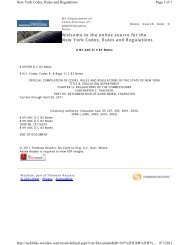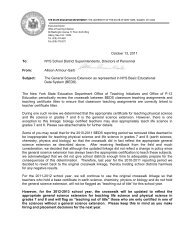ESL Learning Standards - Higher Ed - New York State Education ...
ESL Learning Standards - Higher Ed - New York State Education ...
ESL Learning Standards - Higher Ed - New York State Education ...
You also want an ePaper? Increase the reach of your titles
YUMPU automatically turns print PDFs into web optimized ePapers that Google loves.
Students learning English as a second language will use English to interact with others in social and<br />
classroom situations. They will develop and use skills and strategies appropriate to their level of<br />
English proficiency to communicate effectively with regard to audience, purpose, and setting.<br />
Performance Indicators: See page 24<br />
Advanced<br />
Students complete Intermediate task. Students and teacher<br />
create a list of rules for carrying out classroom routines.<br />
List is decorated and posted on wall.<br />
Performance indicators: 6, 7, 8<br />
English Proficiency Level<br />
Transitional<br />
Teacher gives students a scenario of an activity that they<br />
will participate in (e.g., take a field trip, visit another teacher’s<br />
class for a special event, etc.). Small groups of students<br />
discuss and develop suggestions for rules for this<br />
activity. Group either writes their rules or gives them to<br />
teacher to be written.<br />
Performance indicators: 6, 7, 8<br />
Teacher gives class a scenario of someone in need of assistance<br />
or clarification, and asks students for the most appropriate<br />
question or phrase from the list to use in this case.<br />
Students comment on various responses. In pairs, students<br />
create a scenario, possibly based on a time when they<br />
needed assistance, and ask another pair how they would<br />
respond to the scenario, using questions or phrases from<br />
the list.<br />
Performance indicators: 1, 3, 4, 5, 6, 7, 9, 10, 11<br />
Students role-play getting food from the cafeteria; role-play<br />
includes requesting, refusing, or choosing food items.<br />
Students discuss appropriate behavior, language, and interactions<br />
between the student(s) and the cafeteria worker.<br />
Performance indicators: 1, 4, 6, 8, 9, 11, 12<br />
Students brainstorm appropriate sayings and phrases for an<br />
occasion (holiday, birthday, festival, etc.) and teacher adds<br />
sayings and phrases to the list. Students make a card for<br />
an upcoming occasion.<br />
Performance indicators: 1, 3, 9, 11<br />
Students reproduce list of questions and phrases that ask<br />
for assistance or clarification, using a word processing program<br />
and computer graphics. They add to the list when<br />
possible. Students distribute this list to Beginning-level <strong>ESL</strong><br />
students or to Beginning- level <strong>ESL</strong> classes.<br />
Performance indicators: 1, 3, 5, 6, 7, 8, 9, 11<br />
Students role-play requesting food from the cafeteria for a<br />
friend who cannot serve him- or herself. Students discuss<br />
interactions between and appropriate behavior and language<br />
for the student and the cafeteria worker.<br />
Performance indicators: 1, 3, 4, 5, 6, 8, 9, 11, 12<br />
After reviewing several models of holiday cards that include<br />
short poems, students create their own illustrated card with<br />
a computer program (e.g., “Amazing Writing Machine”) to<br />
send to classmates via classroom mailboxes or classroom e-<br />
mail .<br />
Performance indicators: 1, 3, 9, 11<br />
<strong>ESL</strong><br />
4<br />
Pre-K<br />
– 1<br />
From a class-generated list of appropriate phrases found in<br />
a thank-you letter (including teacher contributions), students<br />
follow a model to write a personalized thank-you<br />
note to a guest speaker or field trip sponsor.<br />
Performance indicators: 1, 7, 9, 11<br />
Students send an e-mail message to establish an e-pal relationship<br />
with a student in another country by following a<br />
model chosen by the student and providing details such as<br />
name, age, hair color, and other personal information.<br />
Performance indicators: 1, 2, 3, 9, 12<br />
Choosing from a number of models, students create a personalized<br />
thank-you letter after a field trip or to a guest<br />
speaker, and indicate favorite parts of the event.<br />
Performance indicators: 1, 2, 7, 9, 11<br />
Students send an e-mail message to establish a pen pal<br />
relationship with a student in another country by following<br />
a model chosen by the student and providing details such<br />
as name, age, hair color, and other personal information.<br />
With a partner, students revise the letter before sending.<br />
Performance indicators: 1, 2, 3, 9, 12<br />
CLASSROOM<br />
TASKS<br />
Sample Classroom Tasks 39
















